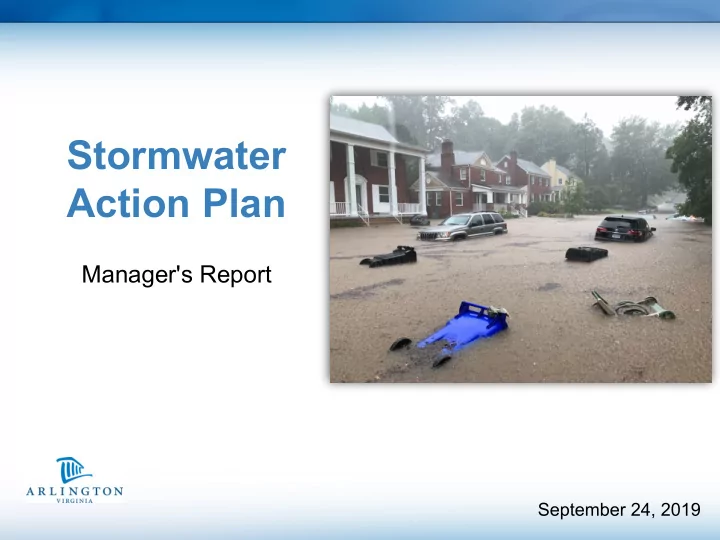

Stormwater Action Plan Manager's Report September 24, 2019
Fast development in 1940s followed History reasonable stormwater standards for the time. Infrastructure designed at a certain Develop capacity to underground streams, and ment lots were built with no overland relief. Summary Overview Emergence of watershed scale & Recent localized flooding from intense short Trends periods of rainfall. Intense storms, coupled with current capacity & limited overland relief, have Result overwhelmed parts of our stormwater system. 2
History and Development • Pre 1930s: Arlington was mostly farmland. Storm drainage was handled privately by landowners. Limited stormwater regulations. • 1930-1950: Population tripled due to federal workforce boom before & after World War II. • Stream network initially served as stormwater management system. 66% of streams were 1920s 1950s encased in stormwater pipes. 3 1930s: View from Rosslyn
1934 Today Waverly Hills – Then & Now • 1934 aerial shows Waverly Hills was un-developed • Stream can be seen prior to development occurring • Most development occurred in the early 40’s 4 • Right aerial of 2019 shows a lot more development has occurred
Recent Storms & Comparison • Impact varies with frequency, duration & rainfall intensity. • 2006, 2018-19: High intensity events caused significant flooding damage & private property loss. • Impact of flashflood event can equal or exceed historical hurricane event. Photo from July 8, 2019 flash flood emergency 5
Flood Damage Calls Map demonstrates flood calls from the following storms in relation to high risk flooding projects identified in Stormwater Master Plan: - July 8, 2019 - July 25, 2018 - May 22, 2018 - June 2006 6
Where We Are - Stormwater Program 7
Ongoing Efforts • County's first Stormwater Master Plan (SMP) was adopted in 1957 and last updated in 2014. SMP remains appropriate for a long-term, balanced program that is focused on the entire spectrum of stormwater challenges, including: o operations and maintenance of existing infrastructure, o capital reinvestment and expansion, o stormwater quality compliance in the context of the MS4 permit, o education and outreach • Risk Assessment & Management Project will identify High Risk Flood Areas based on historic, current & projected storm/rainfall trends, with recommendations for mitigation and adaptation strategies. • Other long-term planning efforts that require legal/regulatory action are being explored. 8
Flood Resilient Arlington Given historical data & recent climate trends, Arlington aims to educate & provide direct support to assist those in high risk flood areas. The following are steps in our communications and outreach plan. 9
Short-Term Outreach Activities • Site visits – visits began in September – 70 high risk homes (“high risk” is characterized as having received more than 4-feet of water during July 8 storm). • Two public forums – October 24 & 26 – experts on flood proof design, flood insurance and installation of floodproof measures • Story Map – Fall 2019 – visual presentation on County website to educate public on historical development & present day stormwater challenges • CIP & Budget Process Engagement – Fall 2019/Spring 2020 – Opportunity for input in capital improvement plan and budget process via online feedback forums and public hearings 10
Homeowners and Business Perspective: • Need to make financial decisions regarding buying/selling/renovations • Would like action from County and when projects will move forward Flood Resilient Arlington How we move forward 11
FY21-30 CIP Investment Strategy • Significant CIP investment: – Address priority high-risk flooding areas, including watershed-scaled projects – Capital maintenance – Maintain water quality/regulatory programs (MS4 Permit) – Deliver other key planning projects (e.g. Risk Assessment Management Project and Initial Utility Feasibility Study) 12
Policy Analysis • Engineering solutions – Upgrade storm sewer system – piping solutions – Detention – large tanks for water storage – Detention with pumping – Property acquisition option for overland relief • Appropriate balance between government vs. private investment must be part of the strategy 13
Public-Private Range of Options Actions that could have meaningful impact on flooding risk over time (Because the water has to go somewhere) 14
Public-Private Options to Reduce Contributory Stormwater Runoff These options manage runoff & accumulation from re/development, not watershed scale challenges Multi-parcel Increase review to design Change lot Plant more limit grade standards for coverage trees change & on-site ratios retaining homes walls onsite More long-term impact 15
What Homeowners Can Do Now • Come to public forums – Thursday October 24, 6:30-8:30 p.m. at Central Library Auditorium – Saturday, October 26,10 a.m.-12 p.m. at George Mason University Arlington Campus in multi-purpose room • Sign up for Arlington Alert • Ask insurance agent about flood insurance and about a sewer backup endorsement to your homeowner’s or renter’s policy • Stay involved with budget & CIP engagement processes 16
Recommend
More recommend